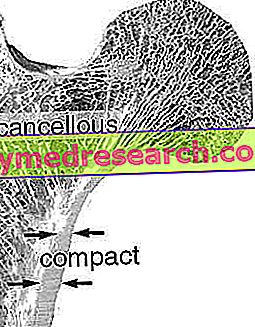Article by Beppe Cart
Right in the middle of the body there is a really ingenious and very resistant structure, but at the same time so light that we can move freely. The skeleton consists of as many as 206 rigid bones ... It is a structure that keeps the body upright and forms a protective cage for the delicate internal organs.

Figure: main bones of the human skull
The most vulnerable organ in the body requires a lot of attention. The brain is protected by 22 bones fused together to form a sort of natural "helmet" that protects it from bumps. But the strongest bones are those that bear the heaviest loads. When the body lands after a jump, the femurs undergo a half-ton impact, a force that would shatter even the granite. Yet the femur is constructed in such a way as to resist this force. The ends of the bone have a honeycomb structure that consists of props and arches, structures that discharge forces on the median section which is stronger and more compact. It is precisely this honeycomb structure that makes the bone resistant and at the same time light.

Figure: the epiphyses (extremities) of the long bones (like the femur shown in the figure) are formed by a so-called spongy (or trabecular) bone-like tissue (in the figure indicated as cancellous). This structure makes the bone tissue lighter and more flexible (therefore easier to move), and is suitable for hosting bone marrow, blood vessels and nerves. The bone trabeculae are a system of finely woven arches and vaults, which delimit these channels and increase the resistance of the spongy bone; not by chance their disposition in the skeleton follows the load lines to which it is usually subjected.
A second type of bone tissue, called compact (in the figure indicated as compact), has instead the task of supporting body weight, protecting the organism and acting as a deposit of minerals. This tissue forms the outer lining of the bones and is also concentrated in the body (diaphysis) of long bones.
This example of the perfection of nature inspired an engineer who worked in Paris at the end of the 1800s. He wanted to design the tallest structure in the world and the most resistant material available at that time was iron. However if he had used too much the structure would have collapsed under his own weight. Inspired by the shape of the femur, the engineer used iron only where it reinforced the structure.
The name of this engineer is GUSTAVE EIFFEL, and his tower has become the symbol of Paris. Just like the props and arches of a femur, the metal bars also discharge all the forces acting on the Eiffel tower on the strongest parts of the tower itself, ie the support bases.
But unlike the Eiffel tower the bones are not stuck in the ground, they are constantly in motion and have to undergo every kind of tension and traction. Any force exerted on the bone triggers a surprising reaction! In response to a mechanical stress, a veritable army of microscopic machines is put into action to build the bone. When a force is applied these cells produce a liquid layer of bone material, then the layer hardens to strengthen the structure. On the contrary, there are areas that do not need to be strengthened and in this case some cells that degrade the bone use hydrochloric acid to dissolve the superfluous material. Just like a team of sculptors, bone cells continually reshape the skeleton to make it strong where it is needed and light where it can afford to be.
But it's not just the bones of athletes that undergo continual change, this process takes place in the bones of all of us ... On average, every year we take about five million steps, each of which helps to reshape our bones. Every action is followed by a reaction !! Exercising strengthens the skeleton, but driving the car weakens it. Human beings therefore continue to reshape their skeleton for life! The bone cells work so intensely that every ten years every person finds himself a completely restored skeleton. So whatever your age, your skeleton cannot be more than ten years old.



